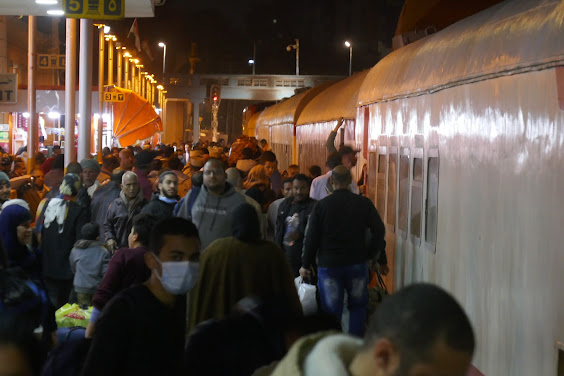ALEXANDRIA
Our second day we drove four hours in our mini-bus NW from Cairo to Alexandria (pronounced al-ex-on-DREE-a) on the Mediterranean. This city is the second largest in Egypt and a major port. It was eponymously named after its founder Alexander the Great. Most tours skip this side trip because it is not filled with temples or great antiquities like Cairo or Upper Egypt. However, I specifically selected this itinerary because I wanted to see this city of historic significance.
 |
| The Cornish from our hotel window. |
 |
| Their buildings are in not much better shape than Havana. And this is the high rent district along the Cornish. |
 |
| Walking the back streets we saw results of their crazy drivers and traffic. |
Besides its founding it was the capital during Cleopatra VII reign, and the love nest of her affairs with Julius Caesar and Marc Antony. This is also where Cleopatra and Antony died in a Romeo and Juliet/West Side Story like ending As Octavius (adopted son of Julius Caesar and later self-named Caesar Augustus) was closing in to end the Roman civil war - and the Republic - after Caesar's murder, Antony, believing that Cleopatra killed herself, unsuccessfully tried to commit suicide by a sword thrust to the gut. Alas, she lived. He thereupon was taken to her where he died in her arms. Upon his death, and Egypt’s loss to Octavius at Actium, she killed herself by the apocryphal legend of an asp bite to her breast. This is unlikely as she was a master of the poison arts, her most probable method of dispatch.
 |
| Legendary Love Affair, in life, art and life |
Alexandria had one of the seven wonders of the ancient world – the Pharos Lighthouse. Six of the seven, including the lighthouse, are gone; only the pyramids survive. The lighthouse collapsed in an earthquake in the late fourteenth or fifteenth century.
 |
| Model of the Pharos Lighthouse in Alexandria |
There is now only a seventeenth century fortress on the site, supposedly built from rubble stones. I’d love it, and think it’d be good for tourism, if they replicated it as it was almost as tall as the pyramids.
 |
| Fortress built from Lighthouse rubble on the Isle of Pharos |
There was also the Library of Alexandria, the largest and most significant library of the ancient world. This was part of a larger institution called a Mouseion dedicated to the Muses, from which we get today’s museum. It is estimated that the library housed about 400,000 papyri from around the Mediterranean. In 48 BCE during the Roman civil war, Julius Caesar, in support of Cleopatra’s claim to rule Egypt, had his soldiers set fire to Egyptian ships commanded by Cleopatra’s brother and rival for the throne. The wind blew the fire from the harbor onto the library and set it ablaze destroying the entire contents. Think how much we’ve learned from four Dead Sea scrolls; imagine what we would know of the times if even a fraction of the contents survived.
 |
| The library of Alexandria ablaze from the ships and the lighthouse at left |
In 2002 a new “Bibliotheca Alexandria” was built on the site of the old. Designed by a Norwegian firm after winning a competition it is dedicated to “recapture the spirit of openness and scholarship of the original Bibliotheca Alexandrina. It is much more than a library.” Initially, I was unmotivated to see a modern library. But after our tour I was very much impressed with both the architecture, it’s purpose, and the exhibits inside. They also have fascinating online resources. Check them out. https://www.bibalex.org/en/default
 |
| Curving exterior facade with all the alphabets of the world inscribed. |
 |
| Cascading tiers of readers under sloping roof with shaded brows for light. |
With the end of our visit to Alexandria we headed to the train station for a 15-hour overnight transit to Aswan in Upper Egypt. We were escorted to the platform by armed security who stood guard around our baggage for several hours. Tourism is the second largest economy in Egypt after the Suez Canal, so they want to be sure nothing disrupts that. Reassuring for us. The station was filled with young and old, conservative and modern Muslims.
 |
| Guards and Guide watch over our baggage on platform |
Only one other western group was waiting. From them a tall middle aged Dutch South African approached. Their group had just spent the week camping in the Sinai desert. While I can certainly relate to the joy of camping in nature and a night under the stars, he beamed with the glow and blazing eyes of spiritual truth. For all we know they might have ascended Mt. Sinai and encountered the blazing bush. Of course, there is a convent at the site, and tours to where the bush was located and to the summit where Moses (Mose) received the tablets. I assume the bush doesn't exist any longer. We will encounter the group in the future, affirming my assumption about their "new age" spiritualism.
Most tourists don’t take this train. It is a local mode of transportation and not of the level of our Blue Star from Cape Town to Johannesburg, or the Ghan in Australia from Alice Spring to Darwin. Because of this we were quite the fascination on the platform. As different trains arrived and left, we’d be greeted from an open window and asked to be photographed, which we willingly engaged with our limited Arabic “Salam Alikum” greeting.
 |
| Young people fascinated with crazy western travelers. |
 |
| Boarding the local by the locals can be quite chaotic |
Our train was scheduled to leave at 20:40; it left on Egyptian time at 22:00.

No comments:
Post a Comment